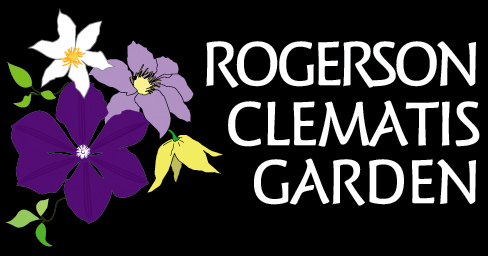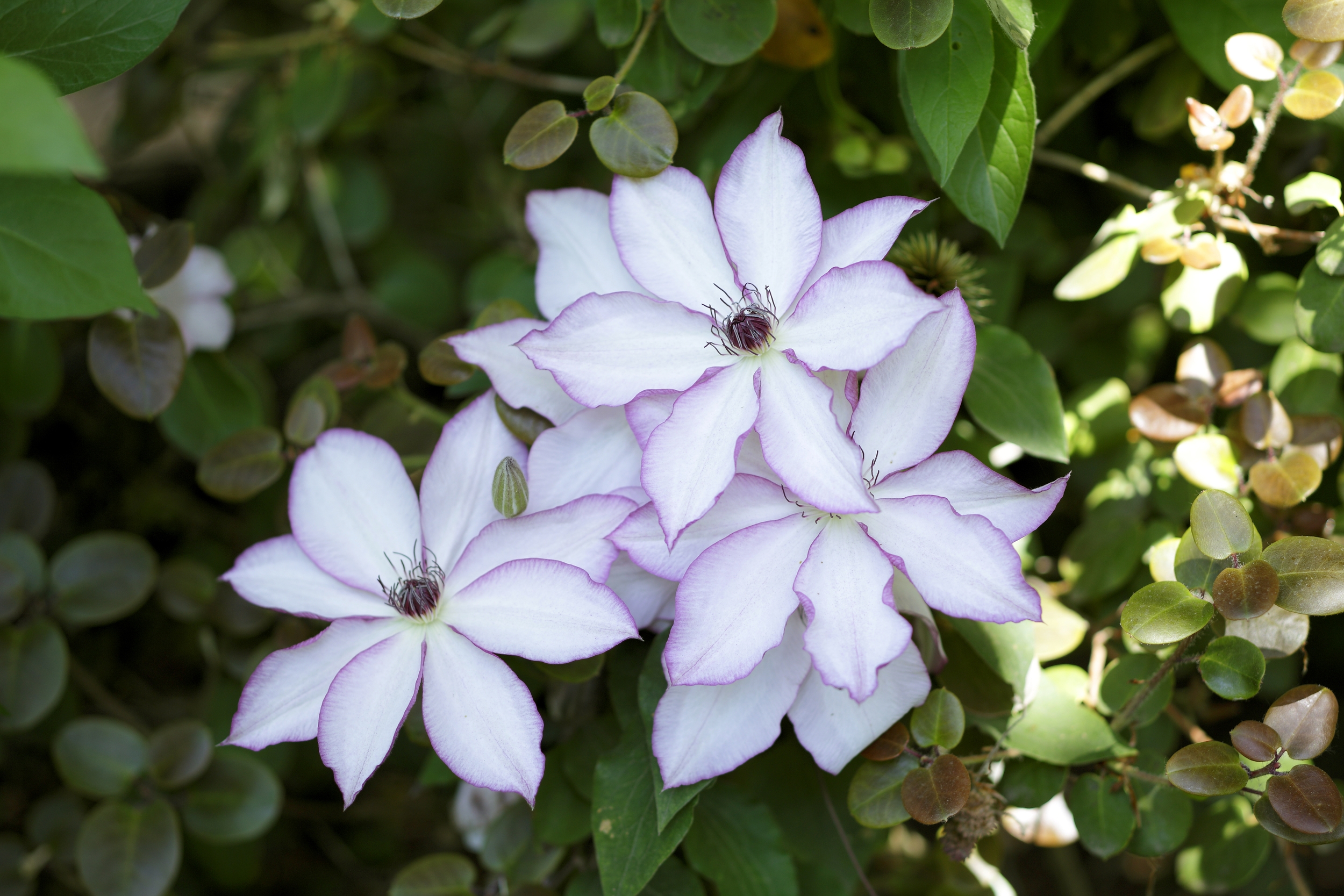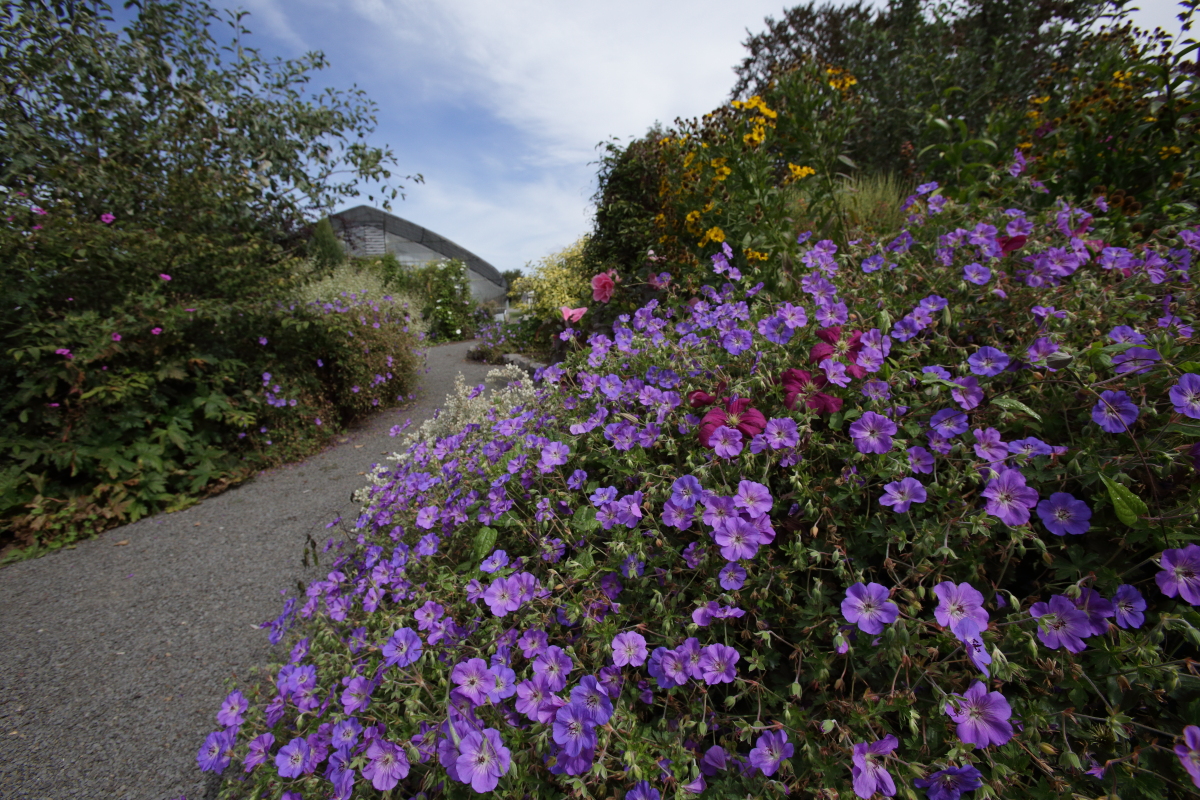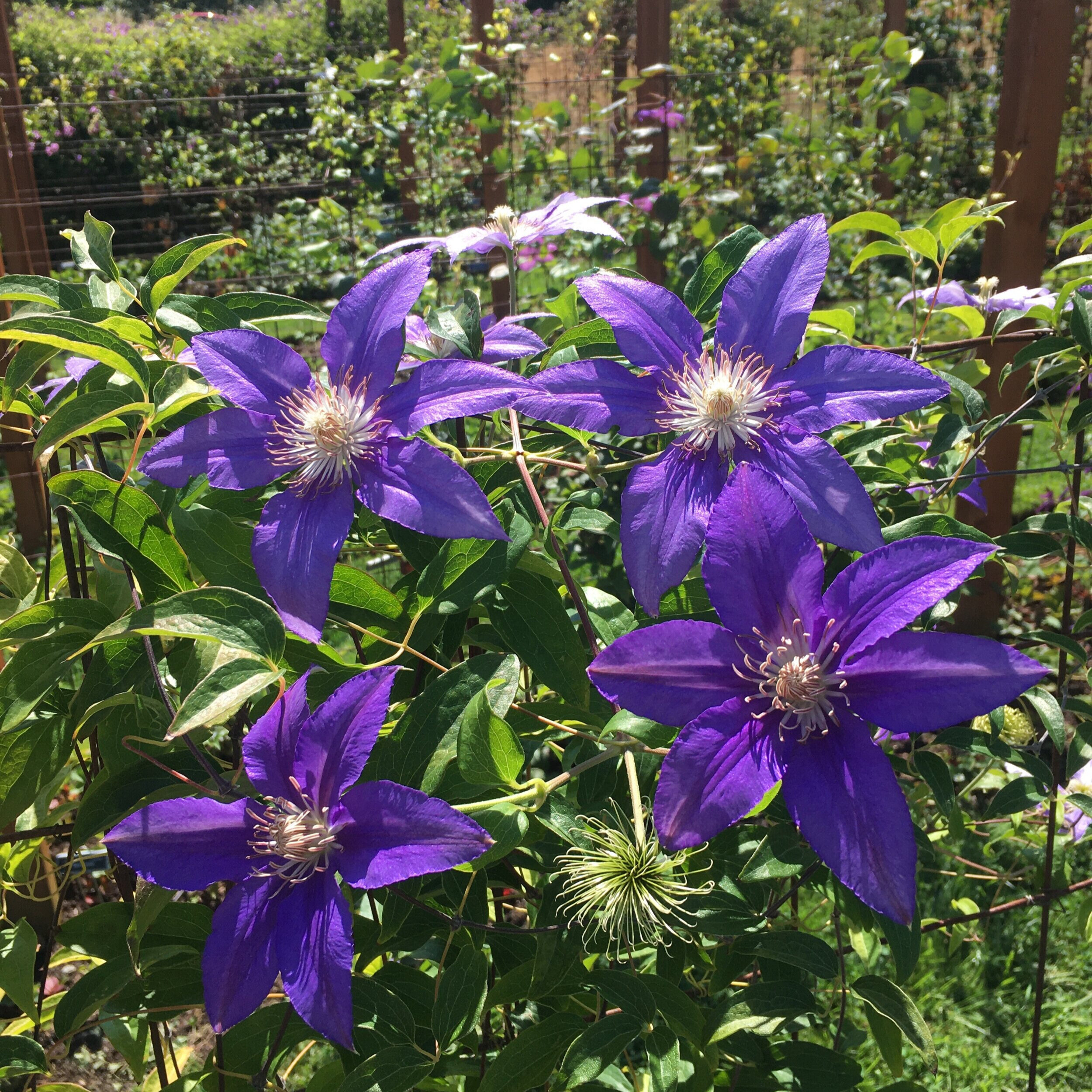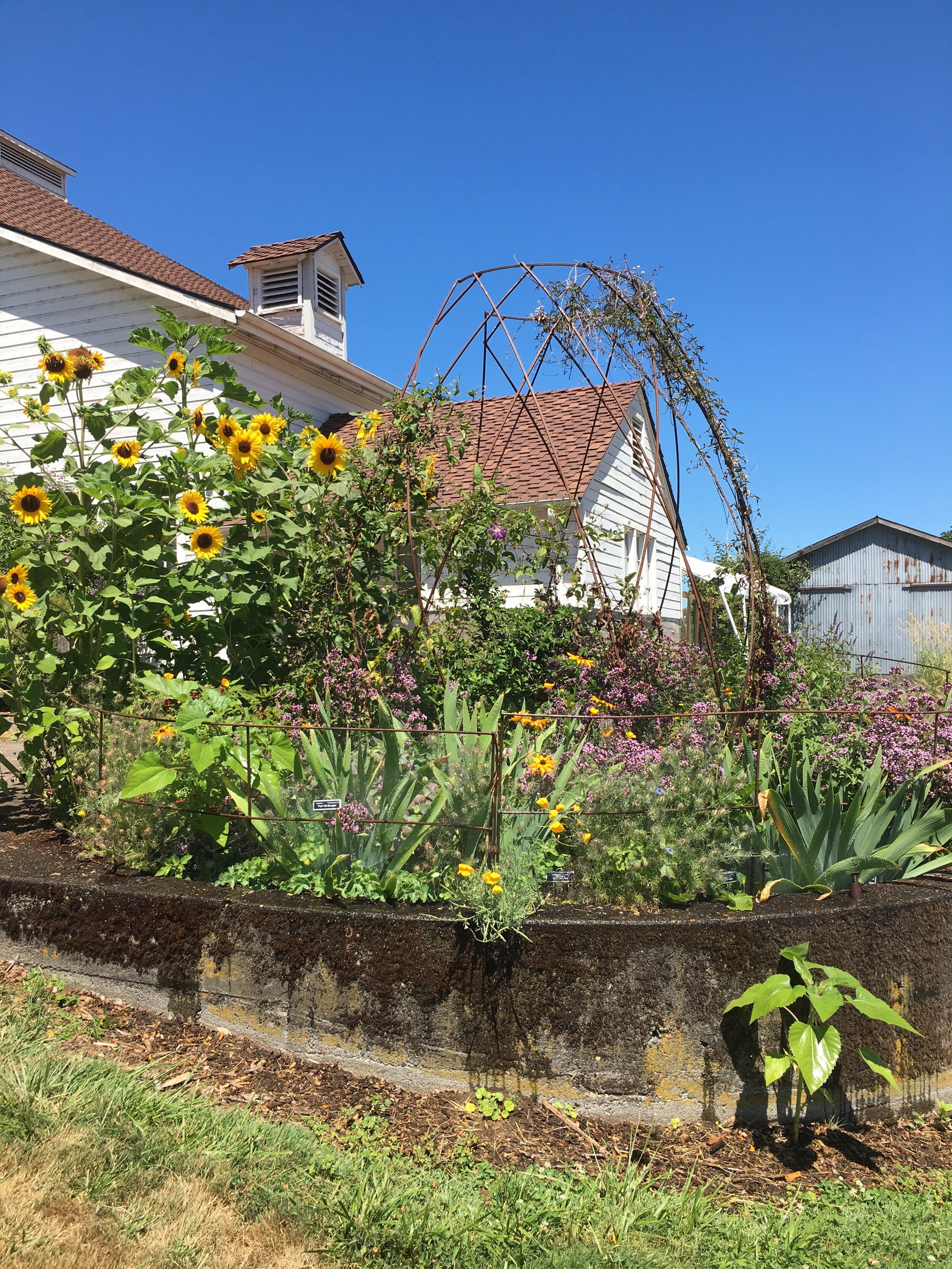Visit the Garden
The Rogerson Clematis Garden is located at Luscher Farm:
125 Rosemont Road, West Linn, OR 97068
The garden is open daily from dawn to dusk. There is no entrance fee. The greenhouse is currently closed to the public.
Free parking is available north and west of the big barn. There is one accessible parking space on the west side of the barn. Please read the parking signs carefully. Luscher Farm is a busy place and there may be temporary changes to the parking areas.
There is one accessible port-a-potty on the north side of the barn.
Paths in the garden are made of compacted gravel and are firm, flat, and stable. They are accessible to most people, including those pushing strollers and using walkers or motorized chairs.
The Modern Garden is not accessible - it is sited in the field south of the driveway. The grass is mowed but the ground is uneven.
Dogs or other pets on fixed-length leashes (not retractable leashes) are welcome on our paths. No pets are allowed on the Sales Terrace unless they can be carried.
We ask that bicyclists of all ages lock their bikes at the bike stands and walk through our gardens.
There’s always something blooming at the Rogerson Clematis Garden. Check out WHAT’S in BLOOM
We also conduct group tours and private classes. Submit the online form to schedule your own private tour or private class!
Enjoy a virtual walk through the garden, thanks to the video made by the talented staff of Lake Oswego's Park and Recreation Department.
Activities
Clematis plants are available for sale on the Terrace or online from April-October. Visit CLEMATIS SALES for more information.
Group tours are available throughout the year. Our docent-led tour fee is $10 per person with a minimum of 8 people. Tours include the greenhouse and the opportunity to purchase plants.
Periodically throughout the year, private classes may be offered as instructor time allows. Topics include:
Starting Clematis from Cuttings (April 15 through June 30)
Starting Clematis from Seed (October 1 through November 15)
Hypertufa Trough Making (January 15 through February 28/29)
Private classes cost $25 per person ($10 for FRCC members). All materials are provided. Attendees may become a member at the class, and enjoy the discounted rate. All classes are held in or just outside the RCG greenhouse. Dress for the weather. Space is limited to 15 people per class.
Visit CLASSES & EVENTS for dates/times.
About the Garden
Taking a unique approach, the clematis are displayed in a residential setting, providing the opportunity to show how well they combine with other plants. It’s a wonderful place to find inspiration and ideas for your own garden. Covering one acre around the historic Luscher farmhouse and the stately 120-year-old copper beech tree, the Garden’s winding paths lead you into the various display areas, each with a special focus. As you’ll see, there’s a clematis for nearly every type of climate and condition.
The garden has many distinct display areas, as shown in the map above. To see a larger version of the map, click on the image.
Entry Border
Our newest feature is a long perennial border opposite the Coop Border. It begins with a metal arc with waving stems of reeds on which large-flowered hybrids climb. Beyond the arc are the other forms of clematis many people don’t know about. Large flat panel trellises are populated by clematis that get very large. They are fronted by clematis that cannot climb, those that are herbaceous perennials, in all of their wonderful colors and flower forms. A row of urns houses draping clematis from the Atragene section (C. macropetala and C. alpina among many other species), which start flowering in April and repeat bloom through the summer. We have some woody shrub clematis here, too! Amid all of this variation within the genus Clematis, we have added an array of herbaceous perennials from groundcovers to tall summer-blooming plants, including lilies and repeated stands of Celtica gigantea (syn. Stipa gigantea, stipa grass). We have carefully selected a few shrubs into which the non-climbing clematis may loll.
The Heirloom Garden
Clematis ‘Comtesse de Bouchaud’, bred in France in 1900
Surrounding the farmhouse, the Heirloom Garden reflects the time period of this historic building. When the Friends group negotiated with the City of Lake Oswego for space, they discovered that a long-held dream of the City’s was to create an antique rose garden around the farmhouse. So, as part of the agreement to move the clematis collection to the farm, the Friends group designed and planted a garden showcasing not only clematis, but over three dozen varieties of old garden roses, plus shrubs and perennial flowers that would have been available to Oregon gardeners around 1900 when the farmhouse was built. Beds 5-13
The Front Bank – Gravel Garden
Clematis ‘Duchess of Albany’, a cross of the US Clematis texensis
In 2005, the City installed a paved path along Rosemont Road, creating a steep, south-facing bank in front of the farmhouse. Many clematis species and hybrids prefer this type of exposure: sun from the ground up. In fact, many of the plants in this bed are native to North America, or are hybrids of them. With gravel for drainage, this garden features companion plants that also thrive in a sunny climate, giving the bank a decidedly Mediterranean look. Bed 14
The Beech Tree’s Garden
With its spreading branches and cool shade, this stately 120-year-old copper beech tree provides the perfect place for a picnic lunch. Complete with picnic tables and a grassy lawn, this garden features clematis from Japan, a country with a long tradition of breeding the flower for subtle shapes and colors. Many of the Japanese clematis species are woodland plants, blending well with Oregon native flowers and shrubs that provide nectar, berries, and cover for songbirds and hummingbirds. In fact, this area has been designated as a Backyard Bird Habitat by the National Wildlife Federation and certified as a Silver Backyard Habitat by the Bird Alliance of Oregon and the Columbia Land Trust. The entire Rogerson Clematis Garden is one of the few wholly organic ornamental gardens in a public park in Oregon. Beds 1-4
The Orchard
Evocative of the old apple orchard that once stood on these grounds, heirloom apple varieties on modern dwarfing rootstock are grown in a grid pattern, surrounded by beds of shrubs, roses, lilies, and, of course, clematis. At the far end of the garden, you will see the gnarled old Gravenstein apple tree from the original orchard.
Bed 15, Hudson's Golden Gem (southern Oregon, 1930s)
Bed 16, Mother (Massachusetts, mid 1800s)
Bed 17, Gravenstein (in situ, cultivar from Denmark, 1797)
Bed 17, Roxbury Russet (Massachusetts, early 17th century)
Bed 18, Westfield Seek-No-Further (Westfield, Massachusetts, 1700s)
Bed 19, Hubbardston Nonesuch (Massachusetts, before 1832)
Bed 20, Esopus Spitzenberg (Esopus, New York, early 1800s)
Bed 21, Yellow Bellflower (Burlington County, New Jersey, 1742)
Bed 22, Arkansas Black (Arkansas, 1840s)
THE Founder’s Garden
Brewster Rogerson began collecting clematis in 1971. The Founder’s Garden, located around a lovely sundial, contains over 40 of Brewster’s favorite clematis, chosen for both aesthetic and sentimental reasons. This garden represents a unique assortment of clematis displayed among conifers and winter-flowering shrubs, showing the vines to their best effect. Bed 16
Baltic Border and Old Poland
Featuring clematis from Poland, Estonia, Ukraine, Russia, Latvia, and Lithuania, the Baltic Border and three Polish beds display cultivars that originated behind “The Iron Curtain.” Large and small, light and dark, these clematis come in all shapes and sizes. Since clematis don’t necessarily require a trellis, you’ll find them creeping along the ground or scrambling through shrubs and perennials. Look for unexpected bursts of color entwined among the heirloom apples that anchor each bed. The Baltic Border is Bed 15. Beds 18-20 are devoted to hybrids created by Brother Stefan Franczak of Poland and his mentor Wladislaw Noll – generously donated to FRCC by Szczepan Marczynski, a clematis breeder and nurseryman in Warsaw, Poland.
THE Beginner’s Garden
Many clematis require expert care, but the varieties in the International Clematis Society (IClS) Beginner’s Garden are specially selected for gardeners who are new to growing clematis. With input from all over the world, there’s something for everyone. Trumpet flowers, globe buds, lanterns, wind socks, and frothy white clusters are just a few of the flower forms you’ll find in these beds. Beds 21 & 22
THE Steppe Garden
Clematis tibetana subsp. vernayi var. laciniifolia
The clematis species in Bed 17 are from the steppe region of Eastern Europe and Central Asia – areas of dry, grassy plains in a windy, semi-arid climate without evergreen cover. These clematis and their hybrids are accustomed to cold winters and hot summers.
The Hedges
Clematis alpina ‘Pamela Jackman’
Along the length of the terrace outside the greenhouse is a hedge of evergreen Tasmannia lanceolata, a perfect host for the spring-blooming alpine and Korean clematis. Both the hedge and the clematis bloom exuberantly in April and May. The clematis rebloom throughout the summer, joined by shrubby clematis (yes, clematis that are woody shrubs!) from July through September. In 2014-15 another bed was added with a yew hedge (Taxus baccata 'Fastigiata') providing the garden's northwest boundary. Beds 23 & 24
Test Garden
Across from bed 23 and along the far western edge of the garden is the Test Garden. FRCC is actively growing plants for identification, to evaluate how they might perform in a garden, and the ease, or difficulty, of growing them. Specimens from as yet undocumented species are grown here to compare them with growth in their native range. Amateur and professional breeders send clematis seeds and plants to us for trials.
The Modern GARDEN
Large-flowered ‘Sally Cadge’ in Row 14
This garden showcases recent introductions from post-World War II on, when clematis re-emerged as “the Queen of the Vines.” Located along the driveway, opposite the farmhouse, clematis in this garden are arranged by color along rows of fencing. The Evison and Marczynski introductions are displayed in specified rows. We grow eight varieties of strawberries to shade the roots of the clematis plants. The end posts are labeled with the name of the strawberry grown in that row. All of our plants are organically grown. Please sample the berries as you wander through the Modern Garden!
WINTER BLOOMING CLEMATIS
Clematis cirrhosa var. purpurascens ‘Freckles’
On the west side of the greenhouse is a long, rock-edged bed with five large trellises and several variations of Pittosporum tenuifolium, a highly ornamental species of evergreen shrub from New Zealand. Here we prove our claim of having clematis in bloom all year round. Winter-flowering species include Clematis napaulensis, plus Clematis cirrhosa var. cirrhosa and its charming selections, which populate the trellises and shrubs, flowering from November through March. Harsh weather may stop their flower fest briefly, but they always bounce back!
the antipodes
Clematis afoliata, the clematis with no leaves. What could be more contrary than that?
The term "antipodes" means "places on the opposite side of the globe," usually referring to Australia and New Zealand. We single out Tasmania as well, since it has clematis found nowhere else. The secondary meaning of "antipodes" is contrariness, and it is the contrary nature of the clematis of The Antipodes that necessitated the installation of special raised beds to provide a slightly higher pH and excellent drainage to assure their health in our wet climate. The raised stone beds are located to the east of the greenhouse opposite the farm’s chicken coop.
THE EGG
Artist James Harrison donated a handsome structure he created using the proportions of a Fabergé egg; hence we call it The Egg. It occupies the round foundation of the long-gone Luscher Farm silo. The cottage garden herbaceous perennials and volunteer annuals (the sunflowers are full of American Goldfinches nearly all day, every day) make a mad display at the feet of the clematis climbing The Egg through the spring and summer.
In 2022 we included some of the magical hybrids and species selections made by the late Ton Hannink, a past president of the International Clematis Society. What better memorial to the man than his plants?
